on July 21st, 2016 | Buying Guides, Interesting
There’s a whirlwind of wedding photos on Instagram. Almost every wedding professional – from make up and hair stylists to caterers to florists to musicians, and, of course, photographers – is competing for attention-grab on the platform. Oh yes, and brides too. The Instagram platform lets one scroll through thousands of images effortlessly, and that makes it into a sort of a wedding magazine on steroids. And don’t think that this is only in the non-Orthodox world. In fact, it would be extremely difficult for a wedding professional even in frum circles to stay in business without maintaining serious social media presence.
Here are some ways that Instagram changed the wedding planning process as well as the wedding planning business. We’ll also include a recent collage of Instagrabs from some of the wedding professional that we follow.
Keeping up with the Joneses
Well, I guess it depends how you look at it. Yes, it can put more pressure on a couple to step up their wedding planning efforts. And yes, that can be unhealthy. But, you could also say, it gives couples access to more choices and wedding ideas. (Perhaps, too many choices?) It probably does all of those things. Without a doubt, for many many brides to be, scrolling through Instagram is now part of the wedding planning process. Double tap this, double tap that and then review the photos you liked in your account profile. You can tag your friends and get their input right on the spot too.
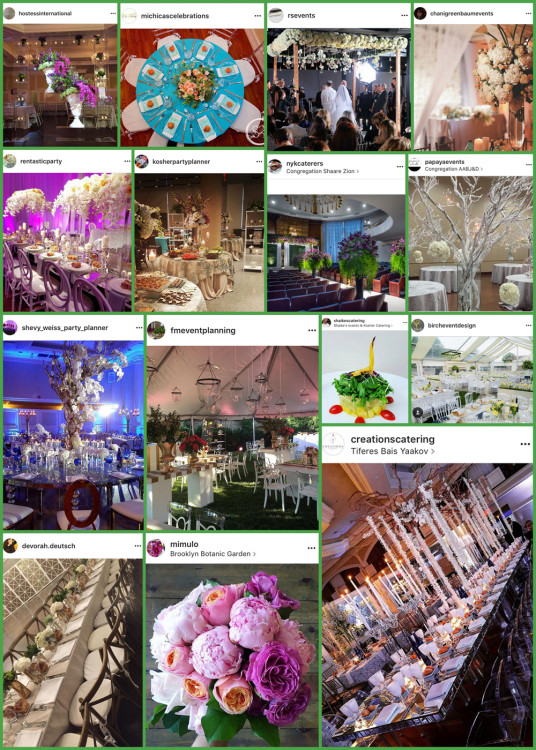
{Florists, Caterers, Party planners, Party Rentals.}
Included in the collage:
Hostess International – @hostessinternational
Michicas Celebrations – @michicascelebrations
Renee S. Erreich Events – @rsevents
Chani Greenbaum Events – @chanigreenbaumevents
Rentastic Party – @rentasticparty
Kosher Party Planner – @kosherpartyplanner
New York Kosher Caterers – @nykcaterers
Papaya Events – @papayaevents
Shevy Weiss Party Planner – @shevy_weiss_party_planner
Frumi Metz Event Planning – @fmeventplanning
Shaikes Catering – @shaikescatering
Birch Event Design – @bircheventdesign
Devorah Deutch – @devorah.deutch
Mimulo – @mimulo
Creations Catering by Nosson Schultz – @creationscatering
More Exposure for Small Business
Instagram is open for all. It doesn’t (yet) have a firewall that keeps commercial pages away from non-commercial ones like Facebook does. This makes it an incredible tool for businesses to reach their customers. It also levels the playing field for big and small businesses. Small businesses, like make-up professionals or starting out photographers, can quickly grow their fan base if they have some Instagram prowess. Or if they can at least plaster each post with a bunch of #hashtags. Of course, this also means that wedding professionals are also their own PR people, and that can be quite overwhelming at times.

{Make Up}
Included in the collage:
Miriam Follman – @makeupbymiriamfollman
Periva Charach – @makeupbypriva
Racheli Shagalov – @racheli_makeup
Gitty Berger – @gittyberger
Abigail Kolb – @missabby_mua
Chava Farkash – @makeupbychava
Ahuva (Sanik) Itzkowitz – @ahuvasanik
Chana Hertz –@chanahertzmakeup
Batya Hess – @makeupbybatya
Miriam Sokol – @miriamsokolmakeup
Business Website, That’s So Yesterday
There’s so much that a small business can do via social media these days, that many wedding professionals have no permanent website at all. Who needs the headache and the costs of constant website maintenance, web security worries, etc, when one can have up to date information, real client engagement, instant exposure, and all absolutely free. Everything a wedding business needs is right in the palm of their hand.

{Photographers}
Included in the collage:
Koby Yedgar – @koby_yedgar_photography
Mendel Meyers (Monsey) – @mendelmeyersmonsey
Nir’s Expressions – @nirs_expressions
Simchavision – @simchavision
Benjamin Kohen – @benjaminkohenphotography
CJ Studios – @cjstudiosphotos
Andre Reichmann – @andrereichmannphotography
Chana Blumes – @chanablumesphoto
Ulrich Studios – @ulrichstudios
Eli Robinson – @elirobinsonphotography
Laibel & Chana Schwartz – @laibelschwartzphotography
Jerry Meyer – @jerrymeyerstudio
Eliau Piha – @eliaupihastudio
Remember OnlySimchas?
Once it was all the rage. A couple would post their wedding picture on OnlySimchas, and let the Mazel Tovs roll in. It was a great way to share a simchah and the only way for out of town relatives and friends to be a part of it. (In a way it was ahead of its time.) Social media changed all that. Wedding pictures hit Facebook, Instagram, well, instantly, and everyone near and far can shower their emoji filled Mazel Tovs to the happy couple. Now, OnlySimchas is a Jewish news website. However, it’s reclaiming its old role via Instagram (@onlysimchas), together with a newer kid on the simcha sharing block – @SimchaSpot.
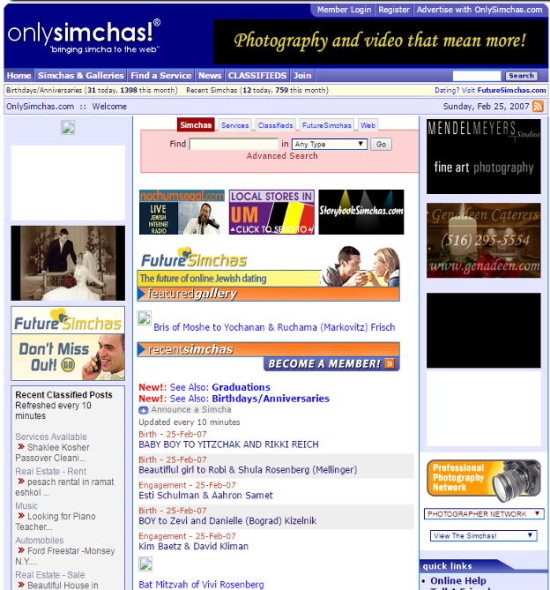
{OnlySimchas.com from 8 years ago.}
Can you add something to this list?
on July 15th, 2016 | Customs & Traditions, Interesting
 If you ever wondered what it takes to transform a non-kosher catering kitchen into a kosher one, then you may be interested in what rabbi Indich wrote on OU Kosher.
If you ever wondered what it takes to transform a non-kosher catering kitchen into a kosher one, then you may be interested in what rabbi Indich wrote on OU Kosher.
Plan on attending your cousin’s Bar Mitzvah party next week? Or your neighbor’s daughter’s wedding next month? As an increasing number of semachot are catered at non-kosher hotels, it is important for the kosher consumer to be aware of what takes place in hotel kitchens. Indeed, oftentimes guests enjoy a lavish smorgasbord (replete with roast rack of lamb and endive and radicchio salad) at a catered hotel affair but have little idea of what, from a kashrut perspective, goes on behind the scenes.
It is important to keep in mind that as a guest at a kosher affair you should never hesitate to question the mashgiach. It is your right to know the standards of the kashrut organization and to feel confident that the mashgiach is doing everything necessary to adhere to the highest kashrut standards.
To better understand the world of kosher catering, let’s take a look at a fictitious evening wedding held at the Sharriot Hotel in New York City.
6 AM: Two mashgichim enter the hotel kitchen to begin preparations. Depending on the size of the event, sometimes as many as three or four mashgichim are needed.
Read more here: OU Kosher
on January 15th, 2016 | Interesting, Wedding Advisor
Only a few years ago, finding a wedding gown that was not strapless was nearly impossible. Virtually every wedding gown in mainstream stores had a neckline that ended way below the neck. These type of gowns still make up the majority of the bridal store rack, but recently, gowns with higher necklines have grown in popularity.
You may say: “well, I never cared about what’s popular anyways.” Not so fast. Fashion trends affect us all. Whether we like it or not, they define, or at the very least strongly influence, our perception of beauty. Just think, what looked good in the 80s or 90s, looks incredibly awkward now
(Here’s an 80’s wedding dress flashback to refresh your memory).
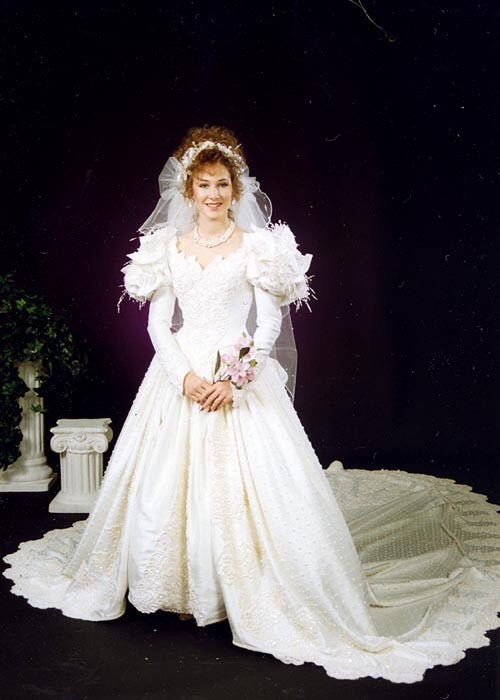
Oh, those puffed shoulders!
In the era of the strapless wedding gown, tznius wedding dresses often looked top-heavy and somehow less elegant. It was significantly more difficult for a frum bride to alter a non-tznius dress without significantly decreasing its appeal. Recent trends in wedding gowns, however, make building up a non-tznius dress a lot easier. Not only because higher necklines such as the jewel, the bateau, the v-neck are coming in, but also because the fabrics are changing as well. More of the wedding dress is made from tulle and lace. Using these fabrics, designers are adding more airiness and lightness to their wedding gowns. 3-d appliqués and feather adornments over the tulle that are in style further accentuate the airiness of the fabric.
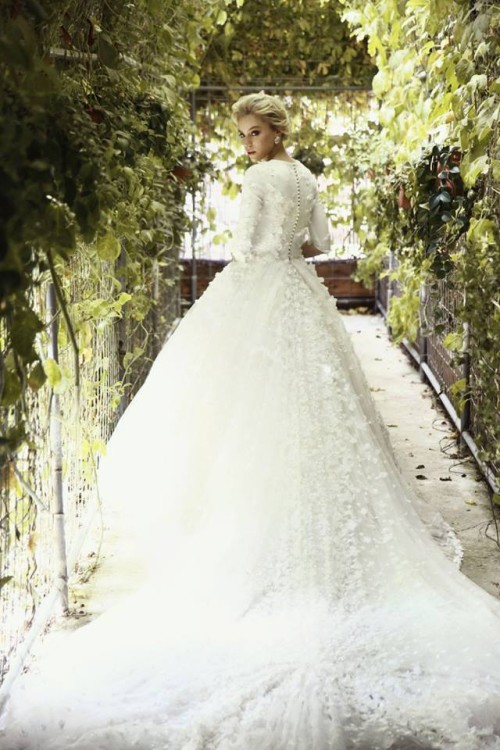
Gown by Israeli Designer Chana Marelus
The lighter fabrics work better with gowns that cover arms and shoulders and make them more pleasing to the eye. Tznius gowns look as elegant and as stylish as the non-tznius ones. Many dresses that are sold in regular bridal stores are easily made tznius by adding sleeves without any additional adjustments. On the downside, large princess ball gowns, which our kallahs like so much, are less common as a result, but that’s a trend we’re prepared to accept. A-lines, sheath, and mermaid (the latter ranking lower on the tznius spectrum) silhouettes are more common.
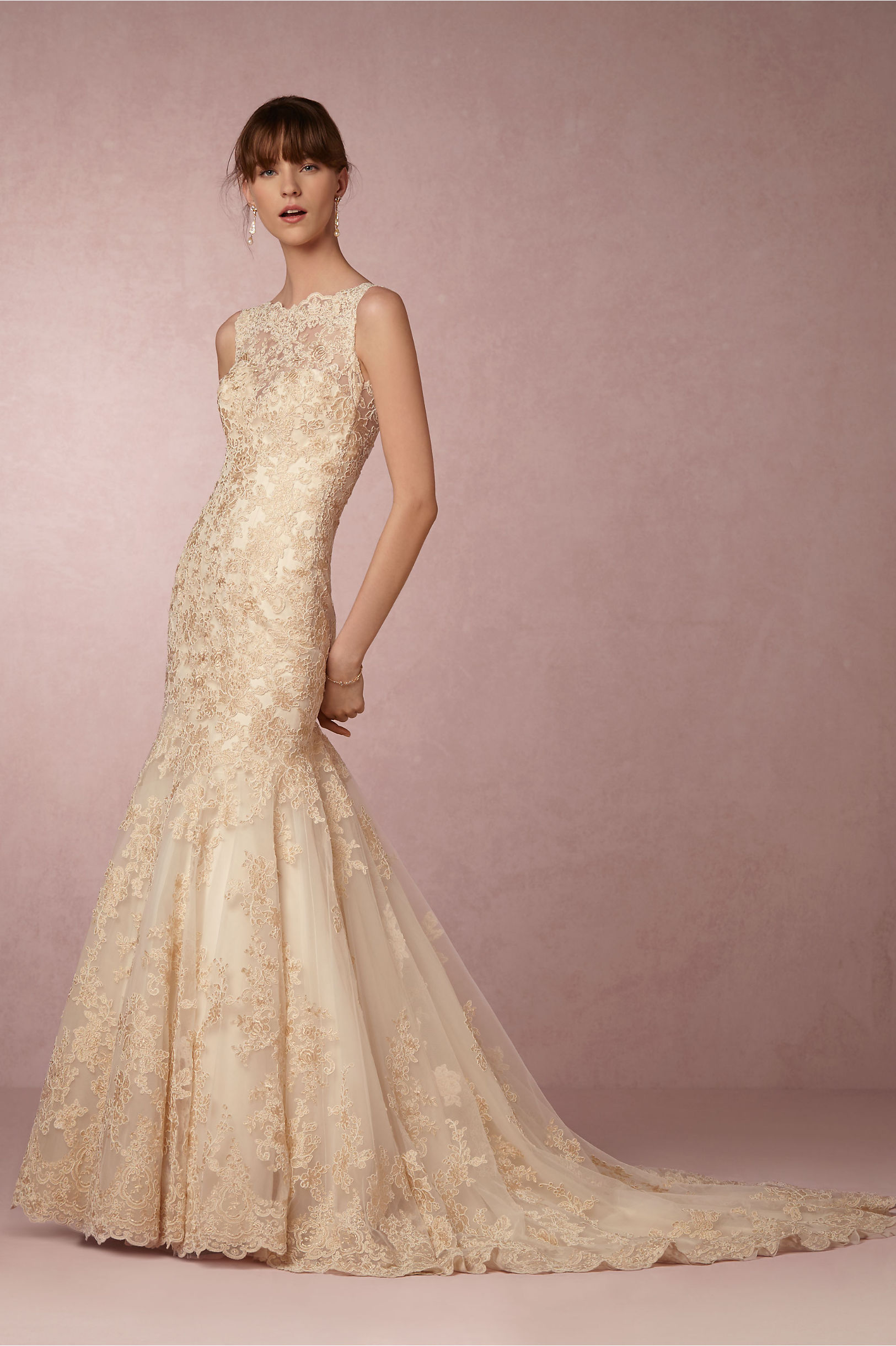
Perla gown by BHLDN – $1,800

Mary by Illume Gowns

Beaded Lace Gown by Oleg Cassini – $1,250

Gown by Chana Marelus
Trends will surely swing back, but for now let us appreciate the additional options available to the frum bride.
on January 10th, 2016 | Ideas and Inspirations, Interesting
The provider of gorgeous wedding inspiration that is the blog that calls itself – the Wedding Chicks, put out their top ten modest wedding gowns. Of course, their version of modest is probably different from most readers of this blog, nevertheless, it’s nice to know that modest gowns is on the radar of blogs like this one.

This gown is by Illume Gowns which specializes in modest wedding gowns.
They also should have included gowns from Chana Marelus – an Israeli designer whose dresses are redefining Tznius bridal and evening wear.
on December 27th, 2015 | Interesting
The National Library of Israel hosts a display of over 4,200 ketubot on their site. The ketubot are from various times and places, and the site allows you to browse the ketubot by year, country, or city.
The text of the Ketubah has remained much the same throughout the ages, but the script and the decorative elements have change with the times and the locations.
Browsing the site, the ketubahs of Amsterdam caught our attention. The Jewish community of Amsterdam has a fascinating history. In the 1600s, after the Dutch won their independence from Spain, Amsterdam quickly became an important European economic center. This was in part to their policy of religious toleration. Sephardic and Portuguese Jews had found a community there – a refuge from the expulsion from Spain; Ahkenazi Jews started to arrive to escape the Chmielnitzki massacres and the horrors of the Thirty Years War.
Seventeenth century Amsterdam is famous for the Amsterdam Stock Exchange – the first of its kind, the Dutch East India Company, and the artist Rembrandt van Rijn, who resided in the Jewish quarter of the city for a number of years, as well as Menashe Ben Israel whose efforts helped Jews gain permission to resettle the UK.
The collection shows that Ketubahs in Amsterdam were of two kinds – the fancy, custom-made kind and the cheaper template kind.
Amsterdam at this time is also a place where contradictory artistic tastes are present in the city. The Protestant north tends to favor simpler, more subdued art, while the south prefers baroque – an over-the-top, dramatic style of art.
Here are two colorful ketubahs from the period of the first kind:
1617

1671

Most of the ketubahs in the collection were using one of the following two printed templates:
Blank Ketubah – 5500s or 1740-1839

This one seems like the no frills, budget option. The one below seems to have been the next step up.
1809

This ketubah template appears often at this time not only in Amsterdam but in the nearby countries as well. And apparently is can be upgraded to a color version.

I’ll end off this post with two photographs by Leonard Freed – a Brooklyn photographer, who spent the late 50s and 60s (that’s 1950s and 1960s) photographing Amsterdam and the Jewish community there.
.jpg)
Succoss, Amsterdam 1958
.jpg)
Jewish Wedding, Amsterdam 1958

← Older Entries













.jpg)
.jpg)